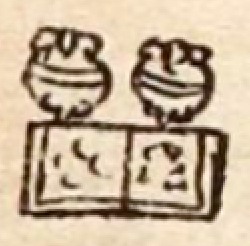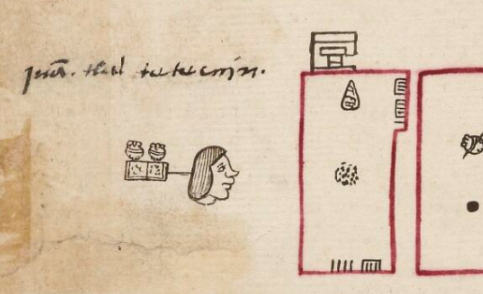Tlaltetecuin (Verg19v)
This black-line drawing of the compound glyph for the personal name Tlaltetecuin (the name of a divine force or deity meaning perhaps “Earth Stomper" or "Earth Pounder") is attested here as a man’s name. It shows two parcels of agricultural land (tlalli) and, above each parcel, a stone (tetl). The tlalli has a border on the lower line and the sides, but not the top. The tlalli is also dotted, seemingly to suggest agriculture. The stones are vertical, they have the curling ends, and the stripes across their middle sections. The reduplicated stone seems to refer to the verb tetecuini, to pound.
Stephanie Wood
Tlaltetecuin is also the name of a divine or sacred force or deity, the Earth Pounder. Tlaltetecuin and Ixtlilton were related deities associated with medicine and dances that bring health, but also with the communication between humans and the divine world. For more information, see Katarzyna Mikulska, Tejiendo Destinos (2015). Might earth pounding have something to do with earthquakes? Or might an Earth stomper be a dancer? Or perhaps one who is tamping down the ground after seeding it? Assistance with the interpretation of this glyph and the deity name would be appreciated.
This glyph has both textual and visual reduplication, and the visual reduplication could be seen in both the tlalli and in the verb, tetecuini, given the parcels and the two stones. The stones are taken here to be logographic and semantic rather than phonetic, in that they are probably considered to be doing the pounding. Signs for tlalli can have borders and elaborate designs that include circles (see below).
Stephanie Wood
juā. tlal.tetecuin
Juan Tlaltetecuin
1539
Jeff Haskett-Wood
pounding, pummeling, golpear, tierras, terrenos, sementeras, lands, parcels, parcelas, tenencia de la tierra

tlal(li), land, https://nahuatl.wired-humanities.org/content/tlalli
te(tl), stone, https://nahuatl.wired-humanities.org/content/tetl-0
tetecuini, to pound, https://nahuatl.wired-humanities.org/content/tetecuini
La Tierra Golpeada
Stephanie Wood
Codex Vergara, folio 19v, https://gallica.bnf.fr/ark:/12148/btv1b84528032/f46.item.zoom
The non-commercial reuse of images from the Bibliothèque nationale de France is free as long as the user is in compliance with the legislation in force and provides the citation: “Source gallica.bnf.fr / Bibliothèque nationale de France” or “Source gallica.bnf.fr / BnF.” We would also appreciate a citation to the Visual Lexicon of Aztec Hieroglyphs, https://aztecglyphs.wired-humanities.org/.







